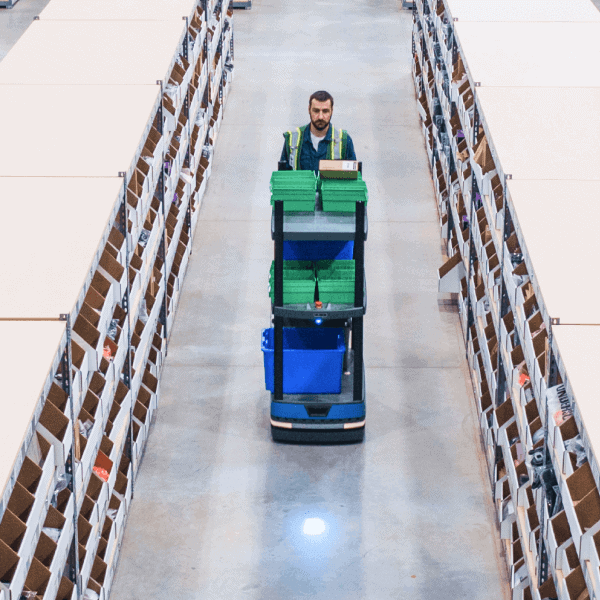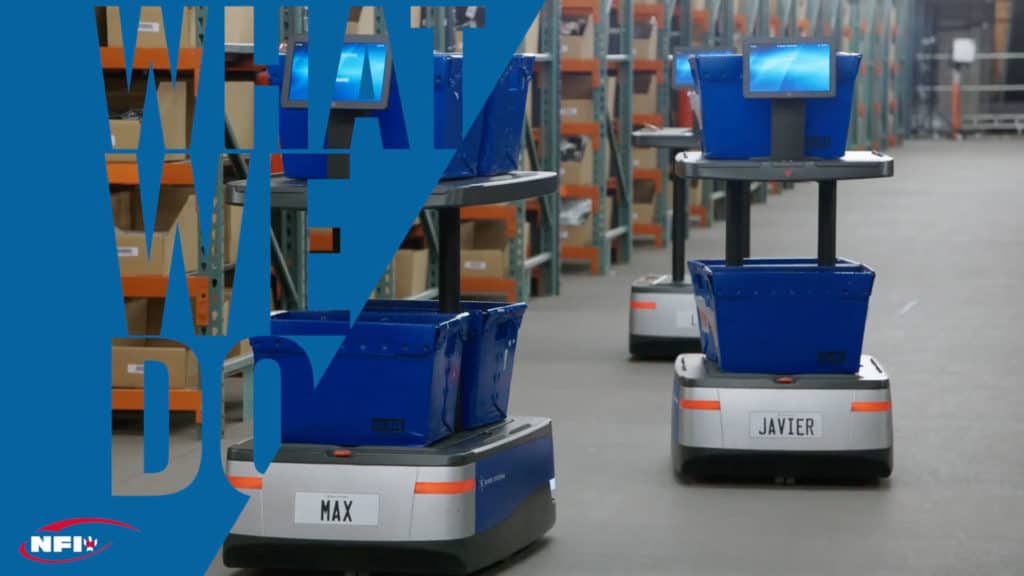Warehouse automation stats show that automation is making a big impact on warehouses and distribution centers. There are many driving forces behind the automation trend, from rising labor costs to rapid growth in ecommerce sales and a growing demand for rapid order fulfillment, such as two-day and even same-day delivery. Labor availability is also a concern, as well as workplace safety.
As technology awareness grows, more warehouses and DCs turn to automation to adapt to the changing landscape. Below, we’ve rounded up 50 compelling statistics to shed some light on the driving forces behind warehouse automation and the impact automation has on the industry.
- General warehouse industry statistics
- Warehousing costs & revenue statistics
- Warehouse efficiency statistics
- Labor statistics in the warehousing industry
- Automation adoption in the warehousing industry
- Warehouse performance metrics
Warehouse automation stats: General warehouse industry statistics
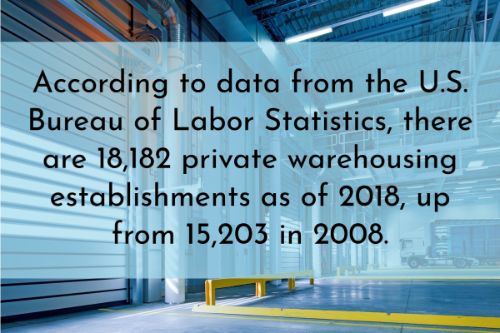
1. The number of private warehouses is growing. According to data from the U.S. Bureau of Labor Statistics, there are 18,182 private warehousing establishments as of 2018, up from 15,203 in 2008.
2. Warehouses are increasing in size, as well. The average size of warehouses in 2000 was about 65,000 square feet, compared to about 181,370 square feet in 2017, according to a 2017 report from Westernacher Consulting. According to the report, “The increase in size helps warehouses to cope with higher volumes and a growing number of SKUs. However, rising costs and long traveling distances in large warehouses are making size expansion less effective in addressing operational challenges.”
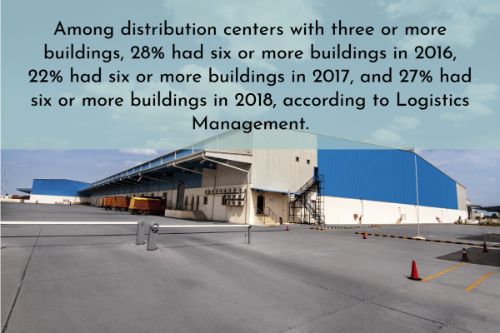
3. A growing number of DCs have multiple buildings. Among distribution centers with three or more buildings, 28% had six or more buildings in 2016, 22% had six or more buildings in 2017, and 27% had six or more buildings in 2018, according to Logistics Management.
4. Distribution centers are growing in size. The average square footage of distribution centers in 2016 was 539,000, increasing to 473,400 in 2017 and 672,080 in 2018. The median square footage of distribution centers was 240,410 in 2016, 176,600 in 2017, and 305,000 in 2018.
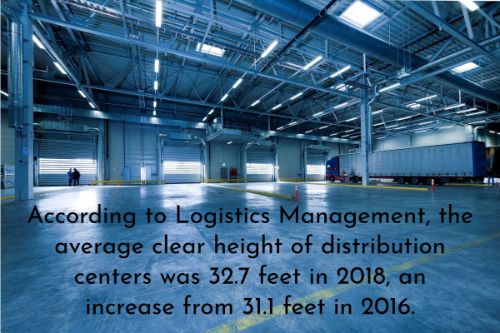
5. Distribution centers are expanding vertically, as well. According to Logistics Management, the average clear height of distribution centers was 32.7 feet in 2018, an increase from 31.1 feet in 2016.
6. Ecommerce demand drives up U.S. domestic revenue for UPS. According to a 2017 press release from UPS, “The Domestic segment benefited from strong demand for ecommerce deliveries and revenue was up 5% over Q1 2016. The U.S. consumer continues to transform retail consumption due, in part to the simplicity, personal convenience and reliable delivery solutions offered by UPS.”
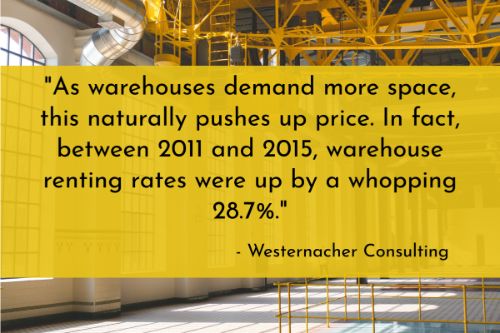
7. The demand for warehouse space drives up prices. Westernacher Consulting explains, “As warehouses demand more space, this naturally pushes up price. In fact, between 2011 and 2015, warehouse renting rates were up by a whopping 28.7%. This trend is likely to continue as the US Industrial Space vacancy rate falls to 5.3% in Q1 2017, the lowest since 2008.”
8. Average warehouse capacity utilization among manufacturers is about 68%. “However, 15% reported that they were at 100% capacity, while 19% were at 81% to 99% capacity. Looking forward for the next two years, 53% expect increased utilization, while only 5% expect a decrease,” according to a 2018 survey by Logistics Management and Peerless Research Group (PRG).
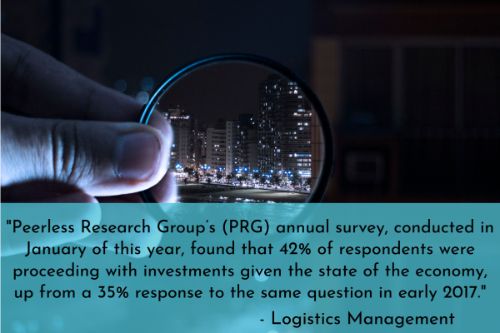
9. More warehouses and distribution centers are investing in automation and robotics thanks to a positive economic outlook. “Peerless Research Group’s (PRG) annual survey, conducted in January of this year, found that 42% of respondents were proceeding with investments given the state of the economy, up from a 35% response to the same question in early 2017. Similarly, only 9% said they were ‘holding off’ on investments, well under the 16% in 2017,” the report explains.
10. Vacancy and availability rates are on the decline. “CBRE’s third-quarter 2018 industrial and logistics indicators were over-performing nationwide, in most markets, both primary and secondary. The overall availability rate declined 10 basis points to 7.1 percent, the lowest level since the fourth quarter of 2000. This marked the 34th consecutive quarter of positive net absorption, the longest streak since 2001. The national vacancy rate edged down to 4.3 percent, the lowest level since at least 2002. Vacancy rates in key transportation hubs and seaport cities were even lower,” according to a report from JOC.com.
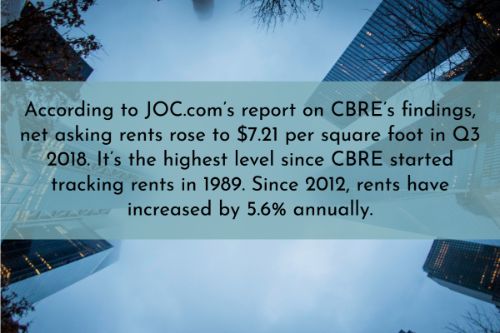
11. Net asking rents continue to rise, as well. According to JOC.com’s report on CBRE’s findings, net asking rents rose to $7.21 per square foot in Q3 2018. It’s the highest level since CBRE started tracking rents in 1989. Since 2012, rents have increased by 5.6% annually.
12. Suppliers face pressure under rising ecommerce sales. “As U.S. e-commerce sales continue to grow at over 15% annually, suppliers feel the pressure to satisfy e-commerce customers by delivering a variety of goods in smaller sizes at a faster pace,” Westernacher Consulting explains.
Warehouse automation stats: Warehousing costs & revenue statistics

13. Companies with high-performing supply chains benefit from higher revenue growth. According to a Deloitte analysis of supply chain leadership, “79% of companies with high-performing supply chains achieve revenue growth superior to the average within their industries.”
14. Distribution costs can impact profitability. In fact, according to Logistics Bureau, “up to 12% of companies are unprofitable after distribution costs are taken into account.”

15. Ecommerce sales of physical goods are skyrocketing. “In 2018, online sales of physical goods amounted to $504.6 billion and are projected to surpass $735 billion in 2023,” according to Statista.
16. Most warehouses and distribution centers take actions to lower operating costs. According to Logistics Management’s 2018 Warehouse / Distribution Center Survey, “Respondents took a range of actions to lower operating costs, including improving processes, improving warehouse information technology (IT), improving inventory control, and leveraging a 3PL. While 98% took actions of some type, one type of action that increased sharply was to improve warehouse IT, which climbed from 38% last year to 50% this year. Using a 3PL also climbed to 15%, while a new option, ‘adding automated equipment to processes,’ also drew a 15% response.”
Warehouse automation stats: Warehouse efficiency statistics
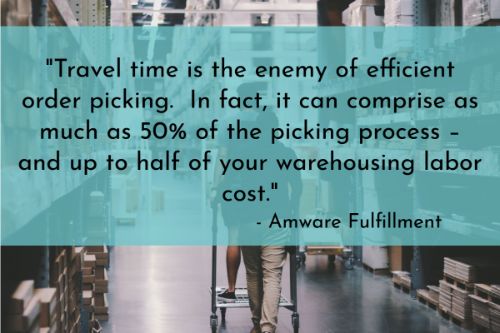
17. Travel time in a warehouse or distribution center accounts for up to half of total picking time. Amware Fulfillment explains that in a fulfillment warehouse, walking is “the enemy of efficient order picking. In fact, it can comprise as much as 50% of the picking process – and up to half of your warehousing labor cost. Without the right system-aided picking process, you’re paying order pickers to walk, not to pick.”
18. Less than one in ten DCs handle only full pallets for outbound shipping. “According to the 2016 Warehouse Operations Survey, only 9% of DCs now handle only full pallets during outbound. Most DCs (46%) now handle a mixture of pallets, cases and split cases. While it still could be time-efficient to deliver pallet orders using traditional labor, it might not be so for cases and split cases. Therefore, many warehouses are turning to case conveyors and robotic picking arms for help. In general, many warehouses found that optimizing piece & case picking gave them the highest ROI,” explains Westernacher Consulting.
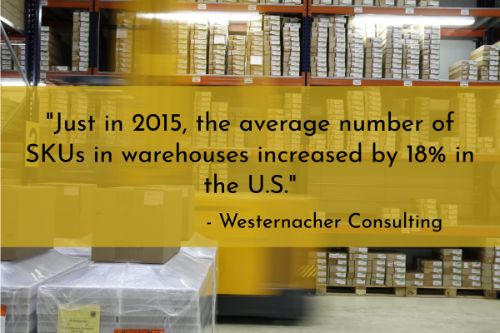
19. Warehouses are handling an ever-increasing number of SKUs. According to Westernacher Consulting, “Just in 2015, the average number of SKUs in warehouses increased by 18% in the U.S. Next year, 38% of companies plan to handle even more SKUs based on PRG’s Research.”
20. More SKUs can be handled with automation solutions. “For 2018, the average number of SKUs in a warehouse reached 13,985, up from 13,130 last year. Additionally, when asked roughly what percentage of SKUs are conveyable or could be handled robotically, respondents’ average answer was 43%, up from 29% last year,” explains Logistics Management.
Warehouse automation stats: Labor statistics in the warehousing industry
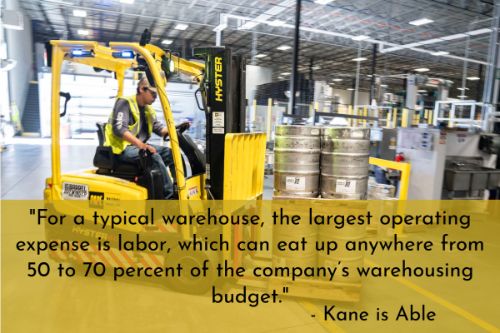
21. Labor comprises 50% to 70% of a company’s warehousing budget. According to Kane is Able, labor comprises the largest portion of a warehouse’s total operating budget, making finding the right people and optimizing warehouse productivity priorities for most warehouses.
22. Warehouses have a high injury rate (about 1 in 20). According to data from the U.S. Bureau of Labor Statistics (BLS), the rate of recordable illness and injury cases in the warehousing and storage sector was 5.1 out of every 100 workers in 2017.

23. Hourly wages in the warehousing and storage sector are on the rise. Data from the BLS shows that hourly wages in the warehousing and storage subsector rose by more than 20% between 2008 and 2017.
24. Hiring and retaining a qualified workforce is a prominent challenge for warehouse managers. “In 2016, a staggering 41% of warehouse managers reported an ‘inability to attract and retain quality hourly workforce’ as one of their top concerns,” according to Westernacher Consulting.
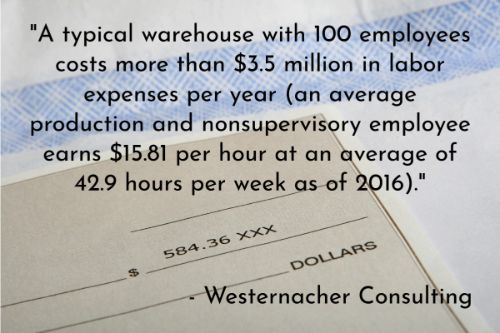
25. A typical warehouse spends millions of dollars in labor expenses annually. Westernacher Consulting explains, “A typical warehouse with 100 employees costs more than $3.5 million in labor expenses per year (an average production and nonsupervisory employee earns $15.81 per hour at an average of 42.9 hours per week as of 2016). This is not considering health insurance, seasonal labor spikes and overtime adjustments.”
26. Temporary workers comprise more than 13% of a warehouse’s workforce, on average, during normal demand periods. According to Logistics Management, the average percent of workers who are temporary during average volume periods is 13.5% of the workforce. During peak volume periods, temporary workers comprise an average of 19.1% of the total workforce.
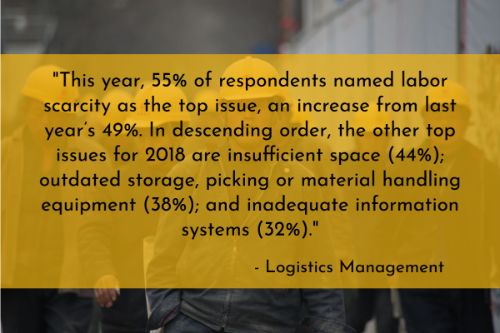
27. Labor scarcity is a top concern among warehouse managers. According to Logistics Management’s 2018 Warehouse / Distribution Center Survey, “This year, 55% of respondents named labor scarcity as the top issue, an increase from last year’s 49%. In descending order, the other top issues for 2018 are insufficient space (44%); outdated storage, picking or material handling equipment (38%); and inadequate information systems (32%). Only on this last issue of IT system capabilities did respondents rank it lower than they did last year, when it drew a 36% response.”
Warehouse automation stats: Automation adoption in the warehousing industry
28. Human error is the most frequent cause of inventory and fulfillment issues. “Humans are not computers. They make mistakes. 62% of respondents reported human error from manual process management as the #1 root cause of inventory fulfillment issues. The key phrase here is ‘manual process management.’ When employees are repeatedly performing manual tasks which require perfect precision – such as entering shipping addresses or SKUs – they will inevitably make mistakes,” explains Stitch Labs.
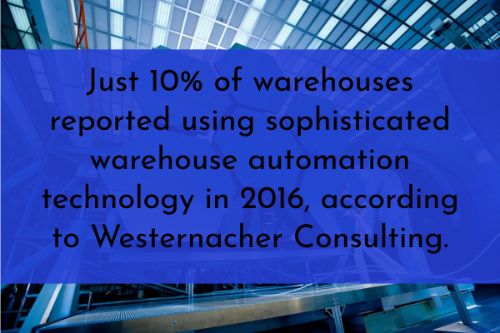
29. Just 10% of warehouses reported using sophisticated warehouse automation technology in 2016. Westernacher Consulting predicts that the percentage of warehouses leveraging sophisticated automation technologies will grow within the next five years.
30. Innovation is important for growth. According to Deloitte, “96% of industry leaders identify innovation as ‘extremely important’ to growth (vs. 65% of followers).” Leaders are defined as organizations with superior supply chain capabilities, while followers are organizations with lower-performing supply chains.

31. High-performing supply chain companies use analytics extensively. “75% of leaders utilize optimization software (vs. 34% of followers), visualization software (67% vs. 28%), mobile technologies (75% vs. 30%), and radio frequency identification tags (65% vs. 27%),” according to Deloitte.
32. Seven out of 10 decision makers plan to increase their technology investments by 2020. According to a study conducted by Zebra Technologies, “51% of those surveyed expected increased investment in real-time location systems that track inventory and assets throughout the warehouse last year, but this number escalates to 76% of respondents in 2020.”
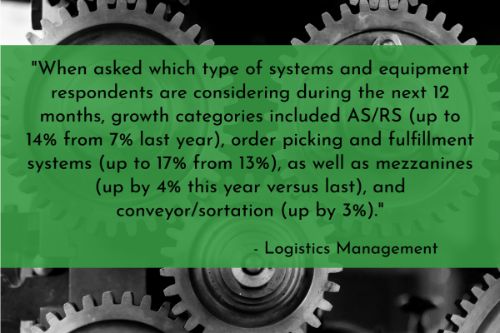
33. AS/RS, order picking and fulfillment systems, mezzanines, and conveyor/sortation systems top the list of investment considerations. “When asked which type of systems and equipment respondents are considering during the next 12 months, growth categories included AS/RS (up to 14% from 7% last year), order picking and fulfillment systems (up to 17% from 13%), as well as mezzanines (up by 4% this year versus last), and conveyor/sortation (up by 3%),” Logistics Management reports.
34. More than three out of 10 warehouses and distribution centers are currently using or considering robotics. “When asked about current robotics use and whether they will evaluate robotics during the next 24 months, 16% said that they currently use robotics, while 15% are evaluating robotics, for a total of 31% now either using or considering robotics. That’s up from last year, when 9% said they use robotics and 13% were considering robotics,” explains Logistics Management.
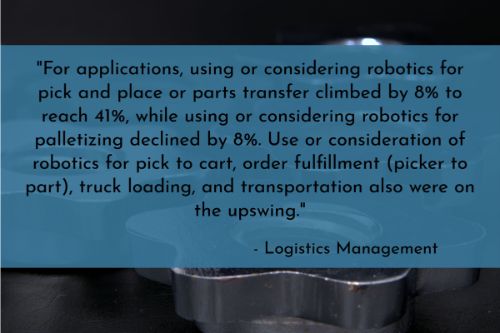
35. Warehouses and distribution centers increasingly leverage robotics for pick and place, parts transfer, pick to cart, order fulfillment, truck loading and transportation. As Logistics Management explains, “For applications, using or considering robotics for pick and place or parts transfer climbed by 8% to reach 41%, while using or considering robotics for palletizing declined by 8%. Use or consideration of robotics for pick to cart, order fulfillment (picker to part), truck loading, and transportation also were on the upswing.”
36. Nearly five out of 10 warehouses and DCs track order cycle times manually. “Currently only 35% of respondents have an automated means of tracking order cycle times, 46% track them manually, and 19% don’t track them. However, when asked how they’ll be gauging cycle time performance in two years, 57% expect they will have an automated means of tracking cycle times, 29% expect they’ll be tracked manually, and those that don’t track cycle time drops to 14%,” according to Logistics Management.
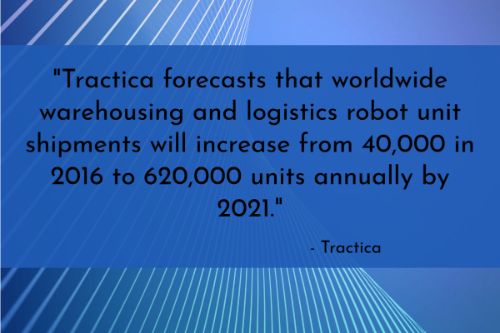
37. Worldwide warehousing and logistics robot shipments are increasing. “Tractica forecasts that worldwide warehousing and logistics robot unit shipments will increase from 40,000 in 2016 to 620,000 units annually by 2021. The market intelligence firm estimates that global market revenue for the sector reached $1.9 billion in 2016 and anticipates that the market will continue to grow rapidly over the next several years, reaching a market value of $22.4 billion by the end of 2021.”
38. System-directed work is increasingly used to automate decision-making. “Moving up are warehouses that use system-directed work to automate decision-making. Here, a Warehouse Management System (WMS) is used to make decisions on where to put away/pick items and manage processes such as deconsolidation, VAS (Value Added Services) and quality inspection. It also optimizes decisions on when to perform the tasks, and who should perform the tasks. System Automation usually involves using Mobile RF (Radio Frequency) Technologies or Voice-directed Technologies to confirm and send stock information to the WMS in real time. In general, most companies observe around a 25% gain in overall productivity, a 10-20% improvement in space utilization, and a 15-30% reduction in safety stock when moving from a paper-based system to this level of automation,” explains Westernacher Consulting.
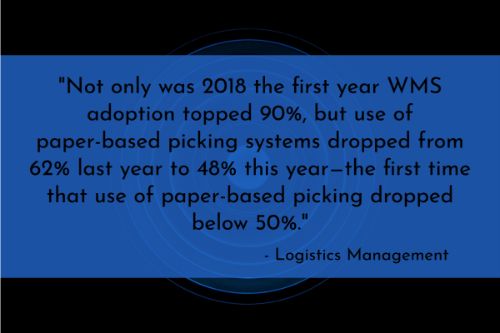
39. In 2018, WMS adoption exceeded 90% for the first time. “Not only was 2018 the first year WMS adoption topped 90%, but use of paper-based picking systems dropped from 62% last year to 48% this year—the first time that use of paper-based picking dropped below 50%,” according to Logistics Management.
40. More warehouses are adopting voice-directed picking solutions. Logistics Management explains, “Other picking technologies and methods on the rise include RF-assisted with scanning, up by 9% versus 2017, and voice assisted with scanning, which reached 12%, up from 7% last year. Voice systems with no scanning came in at 10%, so this year 22% are using some form of voice-directed solution.”
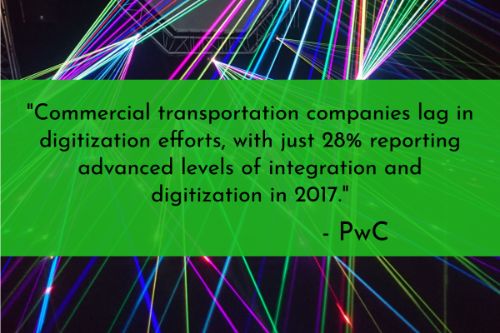
41. Less than 30% of commercial transportation companies leverage advanced digitization. “Commercial transportation companies lag in digitization efforts, with just 28% reporting advanced levels of integration and digitization in 2017,” explains PwC.
Warehouse automation stats: Warehouse performance metrics
42. Capacity and quality top the list of priorities for warehouse operators. According to Material Handling & Logistics, “Warehouse operations are prioritizing quality and capacity, with the top five metrics being:
- Order Picking Accuracy (percent by order)
- Average Warehouse Capacity Used
- Peak Warehouse Capacity Used
- On-time Shipments
- Inventory Count Accuracy by Location”
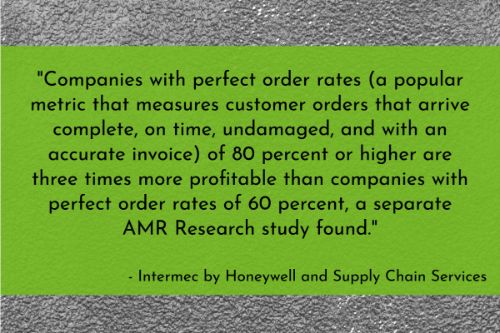
43. Higher perfect order rates lead to greater profitability. According to a white paper by Intermec by Honeywell and Supply Chain Services, “Companies with perfect order rates (a popular metric that measures customer orders that arrive complete, on time, undamaged, and with an accurate invoice) of 80 percent or higher are three times more profitable than companies with perfect order rates of 60 percent, a separate AMR Research study found.”
44. On-time shipments below 94% indicate an opportunity for improvement. Avery Weigh-Tronix explains, “…if your on-time shipment performance is below 94% then this falls in the bottom quintile (20%) of the results and would indicate there is a major opportunity for improvement. However, if on-time shipments are above 99.8% then this would fall within the top quintile of the results and can be considered best-in-class. The median performance for on-time shipment data is 98.20%.” These statistics are based on data from the ‘DC Measures 2018 Trends and Challenges’ report from the Warehousing Education and Research Council (WERC).

45. Best-in-class operations ship more than 99.87% of shipments on time. On-time shipments is the percentage of orders shipped at the planned time, meaning the shipment is off the dock and in transit to the destination.
46. Best-in-class operations pick orders with an accuracy of 99.84% or better. This metric measures the accuracy of order picking based on errors identified prior to order shipment, such as during packaging.
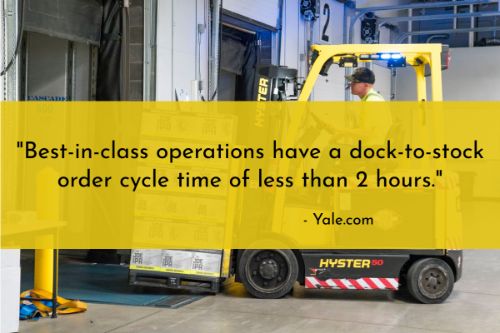
47. Best-in-class operations have dock-to-stock cycle times under two hours (dock-to-stock). “The dock-to-stock cycle time equals the time, typically measured in hours, required to put away goods. The cycle time begins when goods arrive from the supplier and ends when those goods are put away in the warehouse and recorded in the inventory management system,” according to Yale’s Top 10 Warehouse Operational Metrics.
48. Best-in-class operations have internal order cycle times under 3.8 hours. This metric reflects the average time between the supplier receiving an order and shipping it.

49. Total order cycle times average less than seven hours among best-in-class operations. This metric reflects the average cycle time between order placement and final receipt of the order by the end customer.
50. Automated, efficient warehouses benefit from better inventory accuracy, reduced labor costs and prompt shipping. “Automated and efficient warehouses in the survey were 76% more likely to boost inventory accuracy to 99% or higher, 36% more likely to have reduced labor costs an average of 3% per year, and 40% more likely to consistently ship within one day of an order’s placement,” according to Robotics Business Review.
Want to learn more about how automation can benefit your warehouse or distribution center? Download our white paper, 7 Reasons Why Warehouse Robots Beat Traditional Automation, to learn more about how collaborative mobile robots can streamline your fulfillment operations.


